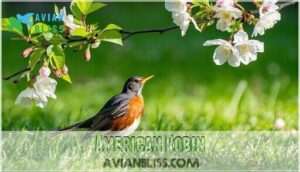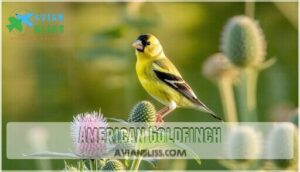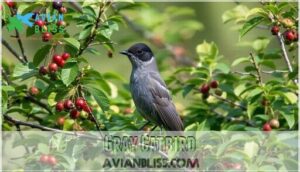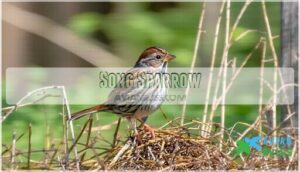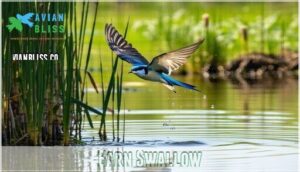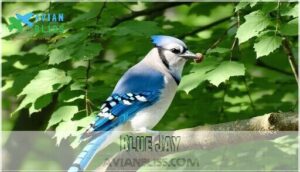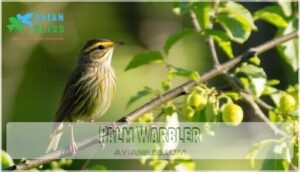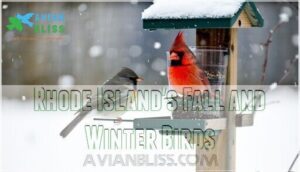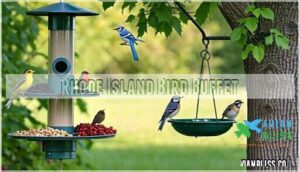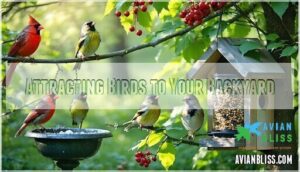This site is supported by our readers. We may earn a commission, at no cost to you, if you purchase through links.
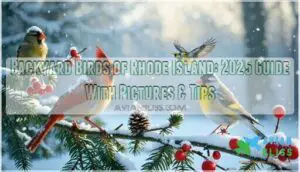
Song Sparrows top the charts, appearing in 45% of local bird reports, while Northern Cardinals and American Goldfinches brighten your yard year-round.
Spring brings energetic Palm Warblers and Barn Swallows, while winter delivers Dark-eyed Juncos and the occasional Snow Bunting.
With over 446 species recorded statewide, your backyard connects coastal marshes to inland forests.
These feathered neighbors aren’t just pretty faces—they’re pest controllers, seed dispersers, and nature’s alarm system rolled into one.
The secret to attracting Rhode Island’s finest feathered residents lies in understanding their seasonal patterns and specific needs.
Table Of Contents
- Rhode Island’s Year-Round Resident Birds
- Rhode Island’s Birds of Spring, Summer, and Early Fall
- Rhode Island’s Fall and Winter Birds
- Supporting Cast (Other Backyard Birds of Rhode Island)
- Rhode Island Bird Buffet
- Rhode Island Birding Hot Spots
- Attracting Birds to Your Backyard
- Birding Etiquette and Ethics
- Explore More: Birds of Prey in Rhode Island
- Frequently Asked Questions (FAQs)
- What is the national bird of Rhode Island?
- How do I find out what birds are in my area?
- What is the most common bird you see near your home?
- How many bird species are there in Rhode Island?
- How do birds migrate through Rhode Island annually?
- Which birds are considered rare backyard visitors?
- What time of day are birds most active?
- How can I identify bird sounds and calls?
- Conclusion
Rhode Island’s Year-Round Resident Birds
You’ll spot these five bird species in your Rhode Island backyard throughout the entire year, making them reliable companions for your birdwatching adventures.
These year-round residents have adapted to New England’s changing seasons and provide consistent opportunities for observation and identification practice.
American Robin
You’ll easily recognize the American Robin by its rust-colored breast and cheerful song echoing through Rhode Island neighborhoods.
This adaptable thrush demonstrates fascinating Robin Behavior as it hops across lawns, pausing to cock its head while listening for earthworms below.
American Robin nesting patterns include building sturdy mud-and-grass cups in trees, returning to favorable sites annually.
Their diverse Feeding Habits encompass insects, worms, and berries, making them perfect Rhode Island birds for backyard birding enthusiasts practicing bird watching year-round.
American Goldfinch
American Goldfinch males flash brilliant yellow plumage during breeding season, while females sport more subdued olive-brown coloring.
These strict vegetarians prefer nyjer and thistle seeds at your feeders. Their unique Goldfinch Migration pattern involves staying year-round in Rhode Island, though they’ll form winter flocks.
Watch for their distinctive undulating flight pattern and listen for their sweet "po-ta-to-chip" calls. During Feather Molting in late summer, males lose their bright yellow breeding colors.
Their late Nesting Habits coincide with thistle seed availability, making them fascinating Rhode Island birds for backyard birding enthusiasts. Understanding their migration timing factors is essential for effective birdwatching and conservation efforts.
Gray Catbird
Several Gray Catbirds will turn your backyard into a concert hall with their impressive vocal abilities.
These slate-gray performers with black caps prefer dense shrubs where they can hide while delivering their remarkable repertoire.
You’ll recognize their distinctive cat-like meowing calls echoing through the undergrowth as they forage for insects and berries.
- Catbird Songs: Masters of mimicry, they copy other bird species and create complex musical phrases
- Gray Plumage: Uniform stone-gray bodies with contrasting black caps and rusty undertail coverts
- Nesting Habits: Build bulky twig nests in thorny shrubs 3-10 feet above ground
- Catbird Diet: Feast on insects, spiders, and seasonal fruits like elderberries and dogwood
These Rhode Island birds showcase remarkable vocal talent while maintaining secretive lifestyles in your backyard’s dense vegetation.
Northern Cardinal
When winter snow blankets Rhode Island, the Northern Cardinal transforms your backyard into a living Christmas card.
These non-migratory Rhode Island birds stay year-round, making them reliable subjects for bird watching enthusiasts.
Males display brilliant red plumage with distinctive black masks, while females wear subtle brown tones with reddish accents.
Their physical characteristics are a key part of their Cardinal Behavior.
Cardinal Behavior includes territorial defense and mate selection during late winter months.
Their Nesting Habits involve building cup-shaped nests in dense shrubs three to ten feet high.
Their Song Patterns feature clear whistles like "birdy-birdy-birdy" that echo through neighborhoods.
Unlike many backyard birds, cardinals don’t follow Migration Routes—they’re permanent Rhode Island backyard birds residents.
Feather Care involves regular preening to maintain their stunning appearance through harsh winters.
This attention to Feather Care is crucial for the birds to survive and thrive in their environment.
Song Sparrow
Song Sparrows thrive in Rhode Island’s dense thickets and brushy areas throughout the year.
These persistent singers bring melodies to Rhode Island backyards through every season, rain or shine.
You’ll recognize their distinctive streaked brown Feather Patterns and bold central breast spot while observing Sparrow Behavior in your backyard.
These Rhode Island birds prefer Song Habitat near water sources, making them common backyard birds for bird watching enthusiasts.
Listen for their melodic "maids-maids-maids-put-on-your-tea-kettle-ettle-ettle" song during breeding season.
Their Nesting Habits include building cup-shaped nests low in shrubs.
Unlike migrating species, Song Sparrows demonstrate minimal Bird Migration patterns, remaining active Rhode Island backyard birds year-round, foraging for seeds and insects.
Rhode Island’s Birds of Spring, Summer, and Early Fall
As spring arrives in Rhode Island, you’ll notice migrant species joining your year-round backyard residents for the warmer months.
These seasonal visitors bring vibrant colors and active behaviors that make spring through early fall the most exciting time for backyard birdwatching.
Barn Swallow
That graceful barn swallow you spot skimming across Rhode Island’s ponds brings spring’s promise with its forked tail and aerial acrobatics.
This backyard bird species demonstrates remarkable migration patterns, traveling from South America each March. Rhode Island birds like barn swallows showcase impressive feeding behavior as aerial insectivores, catching insects mid-flight with precision.
- Nesting habits: Builds distinctive mud cup nests under eaves and bridge structures
- Habitat preferences: Seeks open areas near water sources for ideal foraging opportunities
- Migration patterns: Arrives in Rhode Island during March-April spring migration window
- Feeding behavior: Expertly captures flying insects while performing aerial maneuvers
- Conservation status: Maintains stable populations despite some habitat loss concerns
Rhode Island wildlife enthusiasts appreciate these agile hunters for their insect control benefits and graceful flight displays.
Blue Jay
When Blue Jays arrive in Rhode Island’s spring landscapes, their intelligence becomes immediately apparent through complex social behaviors.
These backyard birds cache thousands of acorns annually, demonstrating remarkable memory skills that support local oak forest regeneration.
Blue Jay behavior includes aggressive territorial displays and sophisticated vocal mimicry of hawk calls to scatter competitors from feeders.
Jay feeding preferences focus on peanuts, sunflower seeds, and suet at backyard stations.
Their brilliant sapphire feather colors and distinctive black necklace markings make bird sightings unmistakable.
Jay nesting occurs in dense tree canopies where pairs raise broods cooperatively throughout summer months.
House Finch
Small House Finch males display vibrant red heads and throats that catch your eye at backyard feeders.
These adaptable ri bird sightings occur mainly during spring and summer months when Finch Behavior becomes most active.
You’ll notice their Flock Dynamics as they feed aggressively on sunflower seeds, often dominating smaller rhode island birds.
Their Beak Health remains strong from cracking tough seeds, while females focus on Nesting Habits using twigs and grasses.
Feather Care keeps their plumage pristine as these resilient bird species continue thriving in suburban environments across Rhode Island’s diverse backyard birds community.
Rusty Blackbird
Migratory Rusty Blackbirds arrive in Rhode Island’s wetlands during spring and fall, displaying their characteristic rust-colored feather patterns before heading to northern breeding grounds.
You’ll find these medium-sized blackbirds wading through shallow waters, using their pointed beak shapes to probe muddy substrates for aquatic insects and invertebrates.
- Habitat Loss: Wetland destruction threatens this species of concern, making ri bird sightings increasingly rare
- Bird Migration: Their flocking behavior creates impressive displays as they move between wintering and breeding territories
- Bird Identification: Look for their distinctive rusty edges on dark plumage during Rhode Island birds migration periods
These sociable blackbirds prefer flooded woodlands and marshes, making wetland conservation vital for maintaining stable bird species populations throughout their range.
Palm Warbler
You’ll recognize the Palm Warbler by its distinctive tail-wagging behavior as it forages through Rhode Island’s shrubby areas during spring and fall bird migration.
This small warbler displays olive-brown feather patterns with yellow eyebrow stripes that help with bird identification.
Palm Warblers prefer habitat preferences including open woodlands and low vegetation where they search for insects and berries.
Unlike other warblers, they spend considerable time on the ground, making them easier to spot among Rhode Island backyard birds, and their warbler songs consist of simple trills, though they’re often quiet during migration through the state with a notable warbler songs pattern.
Rhode Island’s Fall and Winter Birds
As temperatures drop, Rhode Island’s backyard bird population shifts dramatically with the arrival of cold-weather specialists.
You’ll spot hardy species like Dark-eyed Juncos and White-throated Sparrows replacing summer visitors, while year-round residents adapt their feeding patterns for winter survival.
Dark-eyed Junco
When winter arrives, Dark-eyed Juncos become Rhode Island’s most reliable backyard visitors.
These hardy native birds showcase remarkable adaptability in their habitat preferences, thriving in both wooded areas and suburban gardens.
Their migration patterns bring them south from northern breeding grounds, transforming your winter landscape into a bustling bird haven.
- Dark gray "hood" contrasts sharply with bright white belly
- Pink-orange bill perfectly adapted for seed cracking
- Plumage variations include slate-colored and Oregon forms
- Feeding habits focus on ground foraging and seed consumption
- Nesting behavior occurs in northern territories during breeding season
Tufted Titmouse
These crested acrobats arrive in Rhode Island backyards when autumn’s chill settles in. The Tufted Titmouse showcases distinctive gray-blue feather patterns with a prominent crest that makes identification easy.
You’ll spot these New England birds performing upside-down feeding maneuvers at your suet feeders, displaying remarkable bird behavior that entertains backyard observers.
Their nesting habits include using dense woodland areas with brushy understory. During winter months, this bird species keenly consumes sunflower seeds and suet from feeders.
The Tufted Tit’s diet consists primarily of insects gleaned from tree bark and various seeds. Listen for their distinctive "Peter-Peter-Peter" calls echoing through bare branches as these Rhode Island residents prepare for breeding season, exhibiting a unique breeding season behavior.
White-throated Sparrow
Spotting these native birds in your Rhode Island backyard during fall and winter months brings joy to any bird enthusiast.
White-throated Sparrows display distinctive Feather Patterns with brown backs, white underparts, and characteristic white throat patches that make identification straightforward.
These bird species prefer Habitat Preferences including dense undergrowth, woodland edges, and brushy areas where they forage for seeds and insects.
You’ll notice their unique feeding behavior as they scratch through leaf litter with both feet, creating small disturbances in your garden beds.
Song Variations include their famous "Old Sam Peabody-Peabody-Peabody" whistle that echoes through winter landscapes.
Their Migration Routes bring them south from Canadian breeding grounds to overwinter across Rhode Island’s milder coastal climate.
Unlike permanent residents, these backyard birds don’t establish Nesting Sites locally, instead seeking shelter in dense shrubs and evergreen trees for nighttime roosting during their seasonal stay.
Red-breasted Nuthatch
This blue-gray acrobat transforms your backyard into a wildlife theater during Rhode Island’s colder months.
Red-breasted Nuthatches navigate tree bark headfirst, their distinctive nasal "yank-yank" calls announcing their presence.
Their cinnamon-colored breast feathers and bold white eyebrow stripes create striking feather patterns against winter’s backdrop.
Bird migration brings these northern species south when food becomes scarce.
Nuthatch habitat includes mature trees with suitable bark crevices for foraging. Their unique nesting behavior involves smearing pine resin around cavity entrances.
These compact native birds prefer sunflower seeds and suet at feeders, making them easy backyard visitors to attract.
Snow Bunting
Arctic nomads arrive in Rhode Island when harsh northern winds push them south.
Snow Buntings display remarkable Feeder Colors that shift seasonally—males transform from pure white Arctic Breeding plumage to striking black-and-white winter patterns.
These hardy birds adapt their Winter Foraging strategies to survive habitat loss across their Migration Patterns.
You’ll spot these backyard birds hopping through snowy fields, their resilience inspiring bird watching enthusiasts throughout Rhode Island.
5 Snow Bunting Spotting Signs:
- White flash against winter snow – Pure beauty in motion
- Tinkling musical calls – Nature’s gentle wind chimes
- Ground-feeding flocks – Community survival at its finest
- Fence post perching – Perfect photo opportunities await
- Late afternoon golden light – When their feathers truly shine
Supporting Cast (Other Backyard Birds of Rhode Island)
While these five species mightn’t steal the spotlight like cardinals or robins, they’re reliable backyard companions you’ll encounter throughout Rhode Island.
You’ll find these steady performers at feeders and in gardens, each bringing their own practical benefits to your local bird community, and they’re reliable backyard companions.
Black-capped Chickadee
You’ll discover these charming Blackcapped Chickadee birds year-round in Rhode Island backyards, bringing energy to winter feeders.
Their distinctive black cap and white cheeks make identification simple for New England birds enthusiasts.
These small backyard birds exhibit fascinating Chickadee Behavior, hanging upside-down while foraging and caching seeds for winter survival.
Their Chickadee Diet includes insects, seeds, and suet from feeders.
Listen for their cheerful Bird Songs – the classic "chick-a-dee-dee-dee" call that signals their presence.
Their Nesting Habits involve excavating cavities in soft wood, while careful Feather Care helps them survive harsh northeastern winters through efficient insulation.
Understanding their behavior requires knowledge of common backyard birds and their unique characteristics.
- Watch them perform acrobatic feeding stunts that’ll make you smile on gloomy days
- Their fearless curiosity often brings them within arm’s reach of patient observers
- These tiny survivors inspire resilience as they thrive through bitter Rhode Island winters
European Starling
Unlike chickadees with their acrobatic feeding style, European Starlings in Rhode Island showcase remarkable Flock Dynamics through synchronized murmurations.
You’ll recognize these New England birds by their iridescent Feather Patterns—purple and green sheens that shift with sunlight.
Their yellow bills distinguish breeding adults from juveniles.
These backyard birds exhibit complex Starling Behavior, mimicking other bird species’ calls with surprising accuracy.
Their Nesting Habits involve cavity competition, often displacing native species from nest boxes.
Though following established Migration Routes, many Rhode Island populations remain year-round residents.
| Characteristic | Description |
|---|---|
| Size | 7.9-9.1 inches long |
| Plumage | Iridescent black with purple-green sheen |
| Bill Color | Bright yellow (breeding season) |
| Habitat | Urban areas, farmland, backyards |
| Diet | Insects, fruits, seeds, human food scraps |
Despite being non-native, starlings demonstrate impressive adaptability throughout Rhode Island’s diverse bird species communities.
White-breasted Nuthatch
White-breasted Nuthatches patrol Rhode Island backyard trees year-round, defying gravity as they navigate headfirst down bark surfaces.
These compact acrobats use their dagger-like bills to extract insects from crevices while calling with distinctive nasal "yank-yank" notes.
Their nuthatch habitat includes mature deciduous forests where they establish nesting sites in tree cavities.
Watch their feeding patterns as they cache seeds and nuts for winter survival.
These New England birds demonstrate remarkable bird behavior, moving effortlessly in all directions on trunk surfaces throughout their established territory.
Mourning Dove
Throughout Rhode Island’s diverse seasons, you’ll spot the gentle Mourning Dove foraging peacefully in your backyard.
These graceful New England birds showcase remarkable Feather Camouflage with their soft gray plumage and delicate black spots, blending seamlessly into their Mourning Dove Habitat.
- Their melancholy coo-oo-oo Bird Call Patterns create a soothing soundtrack that signals hope and renewal
- Watch their devoted Nesting Behaviors as mated pairs work together, lining nests with pine needles and twigs
- Marvel at their seasonal Dove Migration patterns, though many Rhode Island backyard birds remain year-round residents
House Sparrow
House Sparrows represent one of nature’s most successful urban adapters among Rhode Island backyard birds.
These hardy bird species showcase remarkable Urban Adaptation, thriving in cities where native species struggle. You’ll spot distinctive Feather Patterns on males—gray crowns, black bibs, and chestnut wings—while females display streaky brown plumage.
Their Flocking Dynamics create constant chatter around feeders, where they compete aggressively with House Finch populations. Sparrow Behavior includes year-round activity and opportunistic feeding on seeds, scraps, and insects.
Their messy Nesting Habits under eaves demonstrate incredible resourcefulness in urban environments.
Rhode Island Bird Buffet
Creating the perfect backyard buffet transforms your Rhode Island property into a bustling wildlife habitat that attracts diverse bird species year-round. Strategic bird feeding requires understanding each species’ dietary preferences and selecting appropriate feeder types to accommodate their feeding behaviors.
Your backyard birds thrive when you offer varied bird seed options through multiple feeding stations. Rhode Island birds have distinct preferences that determine your garden layout success:
- Tube feeders filled with nyjer seed attract American Goldfinches and House Finches
- Platform feeders with sunflower seeds draw Northern Cardinals and Blue Jays
- Suet feeders provide essential fats for woodpeckers and nuthatches during winter months
Position bird feeders near natural shelter while maintaining clear sightlines for predator detection. Bird baths placed within ten feet of feeding areas encourage longer visits. Native plants like elderberries and dogwoods complement artificial food sources, creating sustainable bird feeding environments that support Rhode Island’s backyard bird populations throughout seasonal changes.
Effective bird feeding practices involve understanding bird feeding basics to attract a wide variety of species to your backyard.
Rhode Island Birding Hot Spots
Rhode Island offers exceptional birdwatching hotspots that’ll transform your birding experience into unforgettable adventures.
Sachuest Point National Wildlife Refuge stands as the state’s premier coastal destination, where over 200 bird species create a living catalog of Rhode Island’s avian diversity.
Beach birding here rewards patient observers with rare migratory shorebirds and seabirds that coastal trails reveal throughout the seasons.
Trustom Pond National Wildlife Refuge combines salt marshes with freshwater ponds, creating perfect habitat for waterfowl and the elusive Rusty Blackbird.
Wildlife refuges like Ninigret offer diverse coastal environments where your eBird checklist grows with each visit.
Norman Bird Sanctuary provides 200 acres of mixed forest and fields, supporting songbirds year-round.
Nature reserves across the state host community events where experienced birders share knowledge about Rhode Island bird species identification.
Roger Williams Park brings urban birding opportunities right to Providence’s heart, proving that backyard birds thrive in unexpected places.
Bird sanctuaries throughout the Ocean State offer educational programs that deepen your understanding of local species and conservation efforts protecting these remarkable creatures.
Understanding national park habitats is essential for identifying various bird species and their migration patterns.
Attracting Birds to Your Backyard
You can transform your Rhode Island backyard into a bird haven by providing five essential elements that attract and support local species.
These basic requirements include proper feeders, fresh water, nesting sites, protective cover, and native plants that offer natural food sources.
Bird Feeders
Choosing the right bird feeders transforms your backyard into a Rhode Island bird paradise.
Tube feeders attract finches and chickadees with their small perches, while platform feeders welcome larger species like cardinals and jays.
Hopper feeders store substantial seed quantities for extended feeding periods.
Nyjer seed in specialized feeders specifically targets American Goldfinches.
Place feeders at varying heights to accommodate different bird preferences.
Suet recipes in cage feeders provide essential fats for woodpeckers during winter months.
Regular cleaning prevents disease transmission among backyard birds.
Strategic feeder placement near shrubs offers quick escape routes from predators while maintaining clear viewing opportunities for bird attracting success.
Using proper bird feeder techniques can markedly enhance the bird watching experience.
Water Source
Beyond bird feeders, water sources become magnets for Rhode Island birds seeking hydration and bathing opportunities. Install shallow birdbaths with depths under two inches to accommodate smaller species safely. Position water features near shrubs for quick escape routes from predators.
Moving water attracts more birds than static sources. Consider these water management strategies:
- Dripping fountains create irresistible sounds that draw birds from distances
- Shallow pond edges provide safe drinking spots for ground-feeding species
- Clean rain barrels offer fresh water while supporting backyard wildlife conservation
- Regular water changes prevent mosquito breeding and maintain bird feeding habits
Place birdbaths at varying heights to serve different species’ preferences and behavioral patterns. The use of a birdbath fountain can enhance the overall attractiveness of the water feature to birds.
Birdhouses
Proper nesting boxes transform your Rhode Island backyard into prime real estate for cavity-nesting species like chickadees and nuthatches.
You’ll want to match entrance hole sizes to your target birds—1.25 inches for chickadees, 1.5 inches for nuthatches. Mount bird houses 5-10 feet high on stable poles, facing away from prevailing winds and afternoon sun.
Bird shelters need annual cleaning to prevent parasite buildup that can harm returning families. Roosting houses provide winter warmth when temperatures drop.
Consider adding multiple bird nesting options throughout your backyard habitats, spacing them appropriately to avoid territorial conflicts. Quality feeder designs complement housing by ensuring year-round food availability.
Your backyard wildlife will thrive with these thoughtful accommodations. Using birdhouse kits can simplify the process of creating a welcoming environment for birds.
Providing Shelter
Birds need safe spots to escape predators and harsh weather.
Dense shrubs, evergreens, and brush piles create perfect Roosting Sites for Rhode Island species.
Plant Shelter Trees like oak and maple that offer year-round protection.
Leave dead branches standing—they’re natural Nesting Boxes for cavity dwellers.
Your Habitat Creation efforts provide essential bird shelter beyond traditional Birdhouses, supporting diverse bird nesting throughout seasons.
Native Plants
Native plant landscapes serve as backyard bird sanctuaries in Rhode Island, providing essential food sources and shelter year-round.
These Garden Plants support native bird species while requiring minimal maintenance and conserving water resources.
- Native Flowers like black-eyed susans and purple coneflowers produce Bird Seeds that attract goldfinches and sparrows
- Local Shrubs such as elderberry and serviceberry offer Wild Berries for thrushes and catbirds
Dense evergreen plantings create secure bird habitats for winter roosting and nesting protection.
Native grasses provide cover for ground-feeding species while supporting insect populations birds consume.
Strategic plant placement enhances bird conservation efforts by connecting fragmented Rhode Island nature corridors.
Birding Etiquette and Ethics
When you step into Rhode Island’s birding community, remember that Responsible Birding starts with respecting wildlife and their habitats.
Keep a respectful distance from nests and feeding areas—your binoculars work best from afar anyway.
Wildlife Respect means staying on designated trails and avoiding areas marked for Bird Conservation.
Don’t chase birds for better photos or disturb their natural behaviors.
Ethical Feeding involves using appropriate seed types and maintaining clean feeders to prevent disease spread.
Practice Environmental Stewardship by packing out all trash and reporting unusual bird deaths to local authorities.
Join Rhode Island’s bird watching community for birding tips and organized outings that follow established bird watching ethics.
Share your sightings responsibly through eBird or local birding groups.
Remember, we’re guests in their world—your mindful approach helps protect these species for future generations while enriching your own birding experience.
Explore More: Birds of Prey in Rhode Island
Rhode Island’s raptors offer thrilling wildlife encounters beyond your backyard feeders. These powerful hunters showcase nature’s precision through specialized hunting techniques and remarkable adaptations.
Key Rhode Island Birds of Prey to Watch:
- Red-tailed Hawks – Most common raptor, soaring over open fields hunting small mammals
- Bald Eagles – Rebounding populations now nest near coastal areas after conservation success
- Ospreys – Fish specialists with 200 active nests statewide in wetland habitats
- American Kestrels – Colorful falcons facing population declines, supplementing diets with insects
- Great Horned Owls – Nocturnal apex predators dominating diverse owl habitats across forests
Hawk Migration peaks during fall, when Falcon Conservation efforts become most visible. Eagle Nesting sites concentrate along coastlines, while Vulture Behavior patterns shift seasonally. Look for these bird species alongside American Crow and Eastern Towhee in mixed habitats throughout Rhode Island.
Frequently Asked Questions (FAQs)
What is the national bird of Rhode Island?
You’ve got yourself a chicken, not a cardinal—Rhode Island Red hens became the official state bird in
This domesticated fowl breaks tradition by clucking instead of chirping its way to official recognition.
The selection of this breed as the state bird reflects its historical significance to the state, which is a matter of historical and cultural importance, making it a notable choice as the official state bird.
How do I find out what birds are in my area?
You’ll identify local birds by downloading eBird, using field guides, visiting parks with binoculars, and checking local Audubon Society resources for regional species lists and guided walks.
What is the most common bird you see near your home?
Like a familiar melody that greets dawn’s arrival, you’ll likely spot the American Robin most frequently.
These rusty-breasted birds with their distinctive orange-red chests and dark heads are year-round residents that thrive in suburban yards, hunting earthworms and singing cheerfully from perches, making them a common sight in many areas, and their presence is often accompanied by their cheerful singing.
How many bird species are there in Rhode Island?
You’ll find approximately 446 species documented in the Ocean State.
This impressive number includes 173 breeding species that call Rhode Island home.
The count covers everything from common backyard visitors to rare vagrants.
How do birds migrate through Rhode Island annually?
You’ll witness nature’s spectacular flight patterns as birds migrate north for abundant insects and nesting spots in spring.
Then they reverse course southward when food sources decline in fall, traveling overhead at impressive altitudes.
Which birds are considered rare backyard visitors?
You might spot rare visitors like the Red-breasted Nuthatch, Snow Bunting, or Rusty Blackbird.
These species don’t show up often, so grab your binoculars and enjoy the thrill—they’re like hidden gems in your yard.
What time of day are birds most active?
You’ll notice most birds hit peak activity at dawn and dusk, a pattern called “crepuscular.”
These times offer cooler temperatures and less predator threat, so grab your binoculars early or late for the best sightings.
How can I identify bird sounds and calls?
Like piecing together a puzzle, you’ll identify bird sounds by listening for pitch, rhythm, and repetition.
Use field guides or apps to compare calls, then match patterns—think of it as decoding nature’s secret language.
Conclusion
Imagine stepping outside and spotting a new species among the backyard birds of Rhode Island.
Careful observation and systematic note-taking help you track seasonal changes and migration patterns. Use field guides to identify species and record their behaviors.
Keep feeders clean and water fresh to promote avian health. By understanding the needs of backyard birds of Rhode Island, you support local biodiversity and contribute valuable data.
Your backyard can become a living laboratory for scientific discovery year-round.

